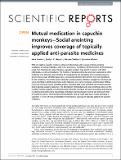Files in this item
Mutual medication in capuchin monkeys - Social anointing improves coverage of topically applied anti-parasite medicines
Item metadata
| dc.contributor.author | Bowler, Mark Timothy | |
| dc.contributor.author | Messer, Emily Jane Elizabeth | |
| dc.contributor.author | Claidiere, Nicolas | |
| dc.contributor.author | Whiten, Andrew | |
| dc.date.accessioned | 2015-10-15T14:09:59Z | |
| dc.date.available | 2015-10-15T14:09:59Z | |
| dc.date.issued | 2015-10-12 | |
| dc.identifier | 215914502 | |
| dc.identifier | 4de4b16d-5931-4551-bb70-3d71280fc1f6 | |
| dc.identifier | 84943799528 | |
| dc.identifier | 000362559000001 | |
| dc.identifier.citation | Bowler , M T , Messer , E J E , Claidiere , N & Whiten , A 2015 , ' Mutual medication in capuchin monkeys - Social anointing improves coverage of topically applied anti-parasite medicines ' , Scientific Reports , vol. 5 , 15030 . https://doi.org/10.1038/srep15030 | en |
| dc.identifier.issn | 2045-2322 | |
| dc.identifier.other | ORCID: /0000-0003-2426-5890/work/65013959 | |
| dc.identifier.uri | https://hdl.handle.net/10023/7657 | |
| dc.description | This research was made possible through Wellcome Trust grants WT094440MA and WT098133A to A. Whiten. The study was begun while NC was supported by a Research Fellowship from the Fyssen Foundation and later by a John Templeton Foundation grant to AW. | en |
| dc.description.abstract | Wild and captive capuchin monkeys will anoint themselves with a range of strong smelling substances including millipedes, ants, limes and onions. Hypotheses for the function of the behaviour range from medicinal to social. However, capuchin monkeys may anoint in contact with other individuals, as well as individually. The function of social anointing has also been explained as either medicinal or to enhance social bonding. By manipulating the abundance of an anointing resource given to two groups of tufted capuchins, we tested predictions derived from the main hypotheses for the functions of anointing and in particular, social anointing. Monkeys engaged in individual and social anointing in similar proportions when resources were rare or common, and monkeys holding resources continued to join anointing groups, indicating that social anointing has functions beyond that of gaining access to resources. The distribution of individual and social anointing actions on the monkeys’ bodies supports a medicinal function for both individual and social anointing, that requires no additional social bonding hypotheses. Individual anointing targets hard-to-see body parts that are harder to groom, whilst social anointing targets hard-to-reach body parts. Social anointing in capuchins is a form of mutual medication that improves coverage of topically applied anti-parasite medicines. | |
| dc.format.extent | 740677 | |
| dc.language.iso | eng | |
| dc.relation.ispartof | Scientific Reports | en |
| dc.subject | BF Psychology | en |
| dc.subject | NDAS | en |
| dc.subject.lcc | BF | en |
| dc.title | Mutual medication in capuchin monkeys - Social anointing improves coverage of topically applied anti-parasite medicines | en |
| dc.type | Journal article | en |
| dc.contributor.sponsor | The Wellcome Trust | en |
| dc.contributor.sponsor | The Wellcome Trust | en |
| dc.contributor.institution | University of St Andrews. School of Psychology and Neuroscience | en |
| dc.contributor.institution | University of St Andrews. ‘Living Links to Human Evolution’ Research Centre | en |
| dc.contributor.institution | University of St Andrews. Institute of Behavioural and Neural Sciences | en |
| dc.contributor.institution | University of St Andrews. Centre for Social Learning & Cognitive Evolution | en |
| dc.identifier.doi | 10.1038/srep15030 | |
| dc.description.status | Peer reviewed | en |
| dc.identifier.url | http://www.nature.com/articles/srep15030#supplementary-information | en |
| dc.identifier.grantnumber | 098133/Z/12/Z | en |
| dc.identifier.grantnumber | 094440/Z/10/Z | en |
This item appears in the following Collection(s)
Items in the St Andrews Research Repository are protected by copyright, with all rights reserved, unless otherwise indicated.

